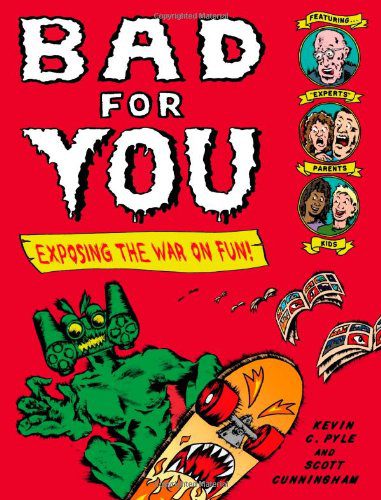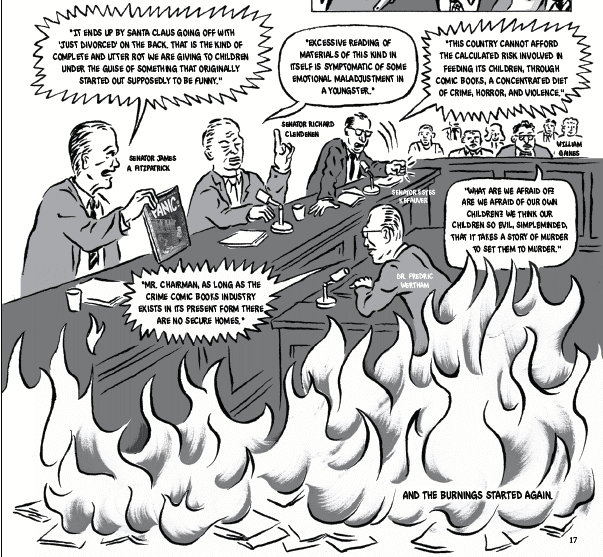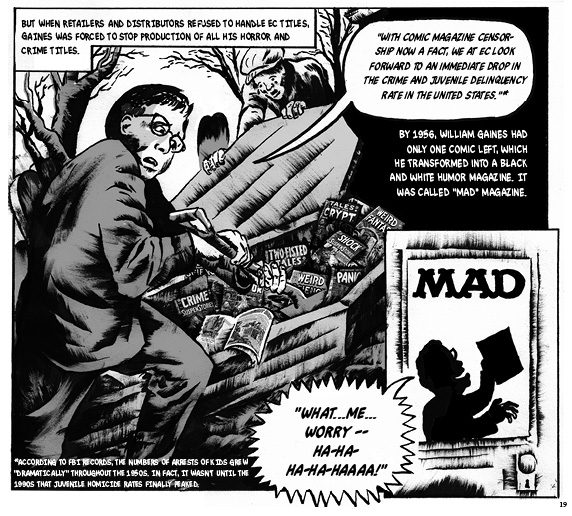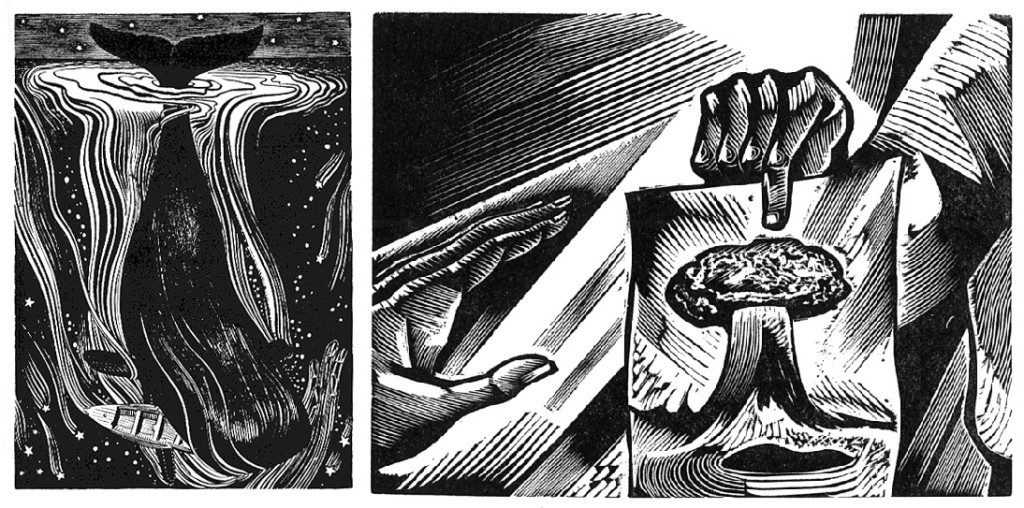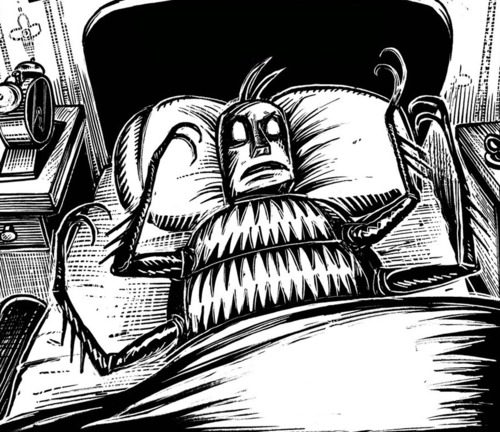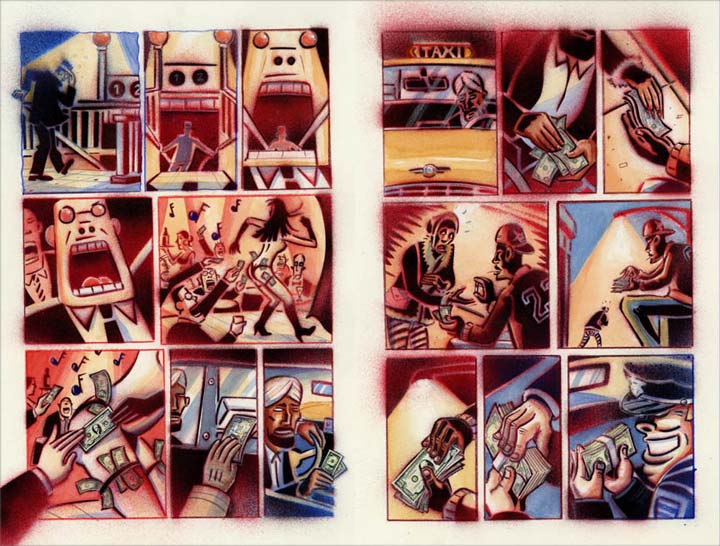The New York Comics & Picture-Story Symposium is a weekly forum for discussing the tradition and future of text/image work. Open to the public, it meets Monday nights at 7-9 p.m. EST in New York City. Presentations vary weekly and include everything from historical topics and technical demonstrations to creators presenting their work. Check out upcoming meetings here.
On Tuesday, February 11th, the 74th New York Comics Symposium featured the writer and illustrator Scott Cunningham and the comics artist Peter Kuper. Scott Cunningham has worked as both an illustrator and writer over the years for publications including Heavy Metal, Mad Magazine, Mad Kids, Nickelodeon Magazine, and Archie Comics, as well as at DC Comics on title such as Vertigo, Looney Tunes, Scooby-Doo, and Cartoon Network Block Party. Peter Kuper is a co-founder of the political graphics anthology WWIII, as well as the author of several graphic novels (Stripped, Metamorphasis, The Jungle, Speechless). He’s contributed illustrations to The New York Times, Time, Newsweek, and MAD Magazine.
Cunningham began the talk by reading excerpts from his graphic history book Bad for You, co-authored and illustrated by Kevin C. Pyle (Henry Holt, 2014). Cunningham began by aptly describing the book as a “historical book about hysterical reactions to the things that kids love.” He explained that since he and Pyle were aiming for a younger readership that they adopted a “melodramatic” tone, one that mimics the crime and horror comics that Bad for You places special emphasis on.
The majority of Cunningham’s reading centered on the birth of comics in the United States, especially on the rise of what would become E.C. Comics, the subsequent backlash to, and enfeebling of, a thriving industry.
By the 1950s, anywhere from 80–100 million comics were being sold in the United States at newsstands every month. The outrage and moral panic amongst parents and community leaders over the supposed corrupting nature of comics was brought about, in no small part, by the now discounted and largely falsified research of Dr. Fredrick Wertham. The stirring rhetoric of Wertham’s magazine articles and books (the most famous, and luridly titled, being Seduction of the Innocent) made comics out to be a major cause of juvenile delinquency, illiteracy, and mental degeneration amongst children in America. In 1954, Wertham testified at the United States Senate Subcommittee on Juvenile Delinquency hearings led by Senator Estes Kefauver. These hearings were deeply damaging to the comics industry. The negative publicity led to the founding of the Comics Book Code, the industry imposed censorship guidelines, which largely sanitized any surviving comics in the market. And many did not survive: between 1954 and 1956 eighteen American publishers stopped printing comics all together. E.C. ultimately discontinued twenty of their titles, almost all.
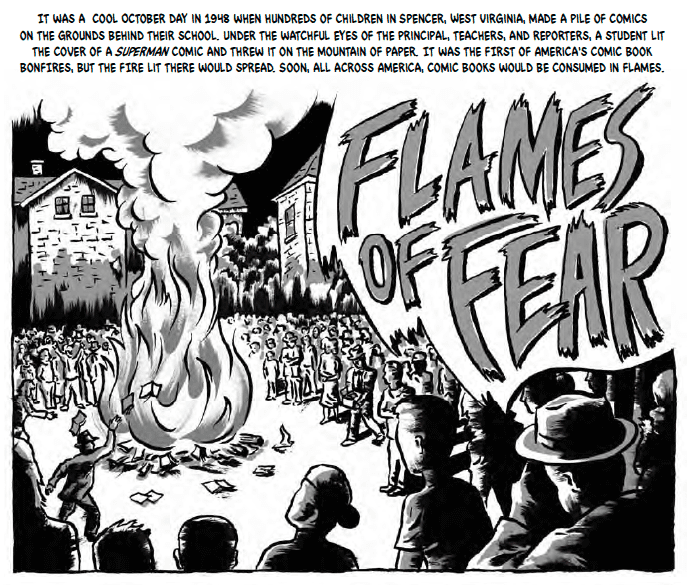 Cummingham’s book, the result of over three years of research, also highlights the alarming comic book burnings which are a perfect, and disturbing, example of how terrified and misled the public was about these supposedly dangerous books. A particularly moving spread in Bad for You is a map of the United States that shows where every publicly reported burning occurred from 1945-55. Cunningham went on to show similar patterns in media reports and parental concern over Harry Potter books (satanic), Dungeons and Dragons (addictive and reality warping), video games (guilty of encouraging numerous sins including aggressive driving), and even playgrounds (too dangerous). His “techno-panic timeline” nicely summarizes the cyclical nature of these panics and the pattern of finding whatever occupies young people to be suspect.
Cummingham’s book, the result of over three years of research, also highlights the alarming comic book burnings which are a perfect, and disturbing, example of how terrified and misled the public was about these supposedly dangerous books. A particularly moving spread in Bad for You is a map of the United States that shows where every publicly reported burning occurred from 1945-55. Cunningham went on to show similar patterns in media reports and parental concern over Harry Potter books (satanic), Dungeons and Dragons (addictive and reality warping), video games (guilty of encouraging numerous sins including aggressive driving), and even playgrounds (too dangerous). His “techno-panic timeline” nicely summarizes the cyclical nature of these panics and the pattern of finding whatever occupies young people to be suspect.
In retrospect, it is hard to imagine that board games and 10-cent comic books were ever seen as inherently corrupting, but they were, despite the fact that the evidence was never really there. Bad for You calls the bluff on hysterical media reports and consternated experts alike. It is a graphic history that empowers young readers to take a critical look at the issues that affect them most of all: the sanitizing of their culture by the hyper-vigilance of an adult world that would eschew their need for fun and creative expression.
***
The comic artist Peter Kuper spoke next, with a two-part presentation on wordless comics entitled “Speechless” (also the title of his retrospective collection [TopShelf Productions, 2000]).
The first part of Kuper’s presentation was a concise and beautiful visual history of wordless comics and graphic arts, ranging from the Codex in 400 AD and the Bayuex tapestries, to the comic art of Will Eisner and Chris Ware. He presented varied examples of this form, highlighting authors that he feels embody the great wordless narrative tradition. Some of the artists and works cited were Frans Masereel (The City, The Sun), the wordless novels of Lynd Ward, Churles Turzak, Rockwell Kent, Milt Gross, Max Ernst, Giacomo Patri (The White Collar), Laurence Hyde (Southern Cross), Eric Drooker (Flood), and Brecht Evan (Nocturnes). Kuper also offered up examples of comics that may have words, but whose strength lies in their long silent stretches, for example Rutu Modan’s Property, as well as instances where words are not meant to be read, as exemplified by the artist Jason.
Kuper argued that as humans we are hardwired to read imagery, as evidenced by the fact that text itself is an extension of visual metaphors and pictograms. Comics, Kuper argued, are in in their infancy, and wordless comics capture the essential power of this visual language. Kuper illustrated, through his slides, the powerful tradition of graphic arts sans text, drawing connections between the art of Katsushika Hokusai and the cartoons of Jules Feiffer and Bill Watterson. Kuper also expounded on the notion that cartooning, illustration, and fine art aren’t proper categories, and that the more you explore the cultural pedigree of these mediums, the more the boundaries between them blur.
The second part of Kuper’s slide presentation traced the arc of his own career, his preoccupation with the wordless format, and the evolution of his artistic methods (from spray paint to scratchboard).
Kuper has been working on one of the most famous wordless comics, Spy Vs. Spy, for the past 18 years for MAD magazine, the longest-lasting and, in fact, last surviving title of William M. Gaine’s E.C. Comics empire. Aside from his work on Spy Vs. Spy, Kuper is the author of various titles, including The System, Sticks and Stones, and Ruins. He concluded the slide show with presentations from these narratives, some set to music. He often interjected to explain various motives and actions, but like the artists whose work he noted earlier in his talk, Kuper’s panels and pages spoke for themselves. They contain within them the clarity of a graphic language that transcends a specific idiom, and speaks instead to a universal human understanding.
***
Image credits:
1. Kevin C. Pyle, Bad for You, Henry Holt, 2014
2. Kevin C. Pyle, Bad for You, Henry Holt, 2014
3. Kevin C. Pyle, Bad for You, Henry Holt, 2014
4. Kevin C. Pyle, Bad for You, Henry Holt, 2014
5. Peter Kuper, The System, Vertigo, 1997
6. Rockwell Kent, Moby Dick, 1930 & Laurence Hyde, Southern Cross, 1951
7. Peter Kuper, Metamorphosis, Broadway Books, 2003
8. Peter Kuper, The System, Vertigo, 1997
***
About the author: Sophia Wiedeman is a comic artist and illustrator who draws and lives in Harlem. She is the recipient of a Xeric award for her comic The Deformitory and the author of the graphic fairytale The Lettuce Girl. You can look at her work over here.

